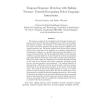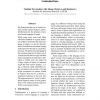501 search results - page 57 / 101 » Improving Language Models by Clustering Training Sentences |
CONNECTION
2006
13 years 8 months ago
2006
We present an approach for recognition and clustering of spatio temporal patterns based on networks of spiking neurons with active dendrites and dynamic synapses. We introduce a n...
IAT
2009
IEEE
14 years 2 months ago
2009
IEEE
—We describe the design of an autonomous agent that can teach itself how to translate from a foreign language, by first assembling its own training set, then using it to improve...
MM
2009
ACM
14 years 2 months ago
2009
ACM
Speaker clustering is the task of grouping a set of speech utterances into speaker-specific classes. The basic techniques for solving this task are similar to those used for spea...
COLING
2010
13 years 3 months ago
2010
We demonstrate the use of context features, namely, names of places, and unlabelled data for the detection of personal name language of origin. While some early work used either r...
IPM
2007
13 years 7 months ago
2007
Information retrieval systems consist of many complicated components. Research and development of such systems is often hampered by the difficulty in evaluating how each particula...


